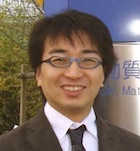
Education:
Ph.D. 2008, Hokkaido University
(Prof. Takanori SUZUKI)
M.Sc. 2005, Hokkaido University
(Prof. Takanori SUZUKI)
B.Sc. 2003, Hokkaido University
(Prof. emer. Takashi TSUJI and Prof. Takanori SUZUKI)
Appointments:
2011–Present Assistant Professor at Osaka Prefecture University
(Prof. Hiroshi IKEDA)
2009–2011 Researcher at RIKEN
(Prof. Takuzo AIDA and Prof. Takanori FUKUSHIMA)
2008–2009 Visiting Researcher at RIKEN
(Prof. Takuzo AIDA and Prof. Takanori FUKUSHIMA)
2007–2009 Research Fellow, The Japan Society for the Promotion of Science (JSPS)
List of Publications:
Original Papers
Bis(10-methylacridinium)s as a Versatile Platform for Redox-active Functionalized Dyes and Novel Structures
T. Suzuki, T. Takeda, E. Ohta, K. Wada, R. Katoono, H. Kawai, and K. Fujiwara
Chem. Rec. 2015, 15, 280–294.
The "Excited State C–C Bond Cleavage—Luminescence" Phenomenon of a Biphenyl-substituted Methylenecyclopropane Triggered by Intermolecular Energy Transfer from Triplet Benzophenone
Y. Matsui, T. Kido, E. Ohta, and H. Ikeda
Chem. Commun. 2014, 50, 13963–13966.
Unexpected Formation of a Phenonium Ion-containing Salt by Single Electron-transfer Oxidation of a Cage Compound Possessing Triphenylamine Moieties
Y. Kuramoto, Y. Matsui, E. Ohta, H. Sato, and H. Ikeda
Tetrahedron Lett. 2014, 55, 4366–4369.
One-pot Photochemical Synthesis of Novel Thienobis[1]benzothiophene with an Angularly-fused Structure that Promotes Unique Intermolecular S•••S Contacts in the Crystalline State
T. Ogaki, E. Ohta, A. Yamamoto, H. Sato, K. Mizuno, and H. Ikeda
Tetrahedron Lett. 2014, 55, 4269–4273.
Theoretical Study Demonstrating that Silylene Bridging Brings about LUMO Energy Lowering without Increasing the Reorganization Energy for Single Electron Transfer
E. Ohta, T. Ogaki, T. Aoki, and H. Ikeda
Chem. Lett. 2014, 43, 755–757.
Remarkable Difference in Fluorescence Lifetimes of the Crystalline States of Dibenzoylmethanatoboron Difluoride and Its Diisopropyl Derivative
M. Tanaka, E. Ohta, A. Sakai, Y. Yoshimoto, K. Mizuno, and H. Ikeda
Tetrahedron Lett. 2013, 54, 4380–4384.
Synthesis and Basic Properties of Tetrathieno[2,3-a:3′,2′-c:2″,3″-f:3‴,2‴-h]naphthalene: A New π-Conjugated System Obtained by Photoinduced Electrocyclization–Dehydrogenation Reactions of Tetra(3-thienyl)ethene
A. Yamamoto, E. Ohta, N. Kishigami, N. Tsukahara, Y. Tomiyori, H. Sato, Y. Matsui, Y. Kano, K. Mizuno, and H. Ikeda
Tetrahedron Lett. 2013, 54, 4049–4053.
The Lifetime and Efficiency of Triplet–Triplet Fluorescence from the Excited State of a TMM Biradical Determined Using Transient Emission Spectroscopy on Two-color Two-laser Flash Photolysis
Y. Matsui, D. Kawahara, E. Ohta, and H. Ikeda
Phys. Chem. Chem. Phys. 2013, 15, 7064–7069.
Remarkable Effects of Terminal Groups and Solvents on Helical Folding of o-Phenylene Oligomers
S. Ando, E. Ohta, A. Kosaka, D. Hashizume, H. Koshino, T. Fukushima, and T. Aida
J. Am. Chem. Soc. 2012, 134, 11084–11087.
White Light Emission from a Single Component System: Remarkable Concentration Effects on the Fluorescence of 1,3-Diaroylmethanatoboron Difluoride
A. Sakai, M. Tanaka, E. Ohta, Y. Yoshimoto, K. Mizuno, and H. Ikeda
Tetrahedron Lett. 2012, 53, 4138–1441.
DFT Studies of Unique Stereoelectronic Effects of Substituents on Divergent Reaction Pathways of Methylenecyclobutanone Radical Cations
Y. Kano, F. Tanaka, E. Ohta, K. Mizuno, and H. Ikeda
Tetrahedron 2012, 68, 5564–5571.
Redox-responsive Molecular Helices with Highly Condensed π-Clouds
E. Ohta, H. Sato, S. Ando, A. Kosaka, T. Fukushima, D. Hashizume, M. Yamasaki, K. Hasegawa, A. Muraoka, H. Ushiyama, K. Yamashita, and T. Aida
Nature Chem. 2011, 3, 68–73.
Drastic Change in Racemization Barrier upon Redox Reactions: Novel Chiral-memory Units Based on Dynamic Redox Systems
T. Suzuki, K. Wada, Y. Ishigaki, Y. Yoshimoto, E. Ohta, H. Kawai, and K. Fujiwara
Chem. Commun. 2010, 46, 4100–4102.
Four-way-output Molecular Response System based on the Dihydrodibenzo[c,g]phenanthrene Skeleton: Modulation of CD and FDCD Activity by Acid and Electron-transfer
E. Ohta, T. Nehira, H. Kawai, K. Fujiwara, and T. Suzuki
Tetrahedron Lett. 2008, 49, 777–781.
Unprecedented Four-way-output Molecular Response System Based on Biphenyl-2,2'-diyldiacridiniums: Induction of Axial Chirality through Intramolecular Hydrogen Bonds between Chiral Amide Groups
T. Suzuki, K. Ohta, T. Nehira, H. Higuchi, E. Ohta, H. Kawai, and K. Fujiwara
Tetrahedron Lett. 2008, 49, 772–776.
Chromic and Fluorescence Response System Based on the Dihydrophenanthroline—Bipyridine Skeleton: Dynamic
Redox Behavior and Metal Binding Properties
T. Suzuki, R. Tamaki, E. Ohta, T. Takeda, H. Kawai, K. Fujiwara, and M. Kato
Tetrahedron Lett. 2007, 48, 3823–3827.
Electrochiroptical Systems Based on Biphenyl-2,2'-diyl-type Dicationic Dyes: Strong Chiroptical Signals through the Transmission of Point Chirality to Axial Chirality
T. Suzuki, T. Iwai, E. Ohta, H. Kawai, and K. Fujiwara
Tetrahedron Lett. 2007, 48, 3599–3603.
Butane-1,4-diyl Dications Stabilized by Steric Factors: Electrochiroptical Response Systems Based on Reversible Interconversion between Dihydro[5]helicene-type Electron Acceptors and Electron-donating 1,1'-Binaphthyls
E. Ohta, H. Higuchi, H. Kawai, K. Fujiwara, and T. Suzuki
Org. Biomol. Chem. 2005, 3, 3024–3031.
First Stable 7,7,8,8-Tetraaryl-o-quinodimethane: Isolation, X-ray Structure, Electrochromic Response of 9,10-Dihydrophenanthrene
S.-i, Iwashita, E. Ohta, H. Higuchi, H. Kawai, K. Fujiwara, K. Ono, M. Takenaka, and T. Suzuki
Chem. Commun. 2004, 2076–2077.
Electrochiroptical Response of
2,2'-(2,2-Diarylethenyl)binaphthyl-type Electron Donors that Undergo Reversible C–C Bond Formation/Breaking upon Two-electron Transfer
H. Hiroki, E. Ohta, H. Kawai, K. Fujiwara, T. Tsuji, and T. Suzuki
J. Org. Chem. 2003, 68, 6605–6610.
Reviews
Dynamic Redox Systems as Electrochromic Materials: Bistability and Advanced Response
T. Suzuki, E. Ohta, H. Kawai, K. Fujiwara, and T. Fukushima
Synlett 2007, 6, 851–869.
|
|
Name:
Eisuke OHTA
Date of Birth:
July 17, 1979
Place of Birth:
Hokkaido
Current Position:
Assistant Professor (Hiroshi IKEDA Lab.),
Department of Applied Chemistry,
Graduate School of Engineering,
Osaka Prefecture University
Research Interest:
Organic Chemistry,
Physical Organic Chemistry,
Photoorganic Chemistry,
Electroorganic Chemistry,
and Polymer Science
Affiliated Academic Societies:
The Chemical Society of Japan
The Society of Polymer Science, Japan
The Kinki Chemical Society, Japan
The Society of Synthetic Organic Chemistry, Japan
The Society of Physical Organic Chemistry, Japan
The Japanese Photochemistry Association
The Society of Silicon Chemistry JAPAN

Contact:
Eisuke OHTA, Ph.D.
Department of Applied Chemistry,
Graduate School of Engineering,
Osaka Prefecture University
Room: 6C-65, Bldg. B5
Address: Gakuen-cho, Naka-ku, Sakai,
Osaka 599-8531, Japan
Phone: +81-72-254-9389,
|

